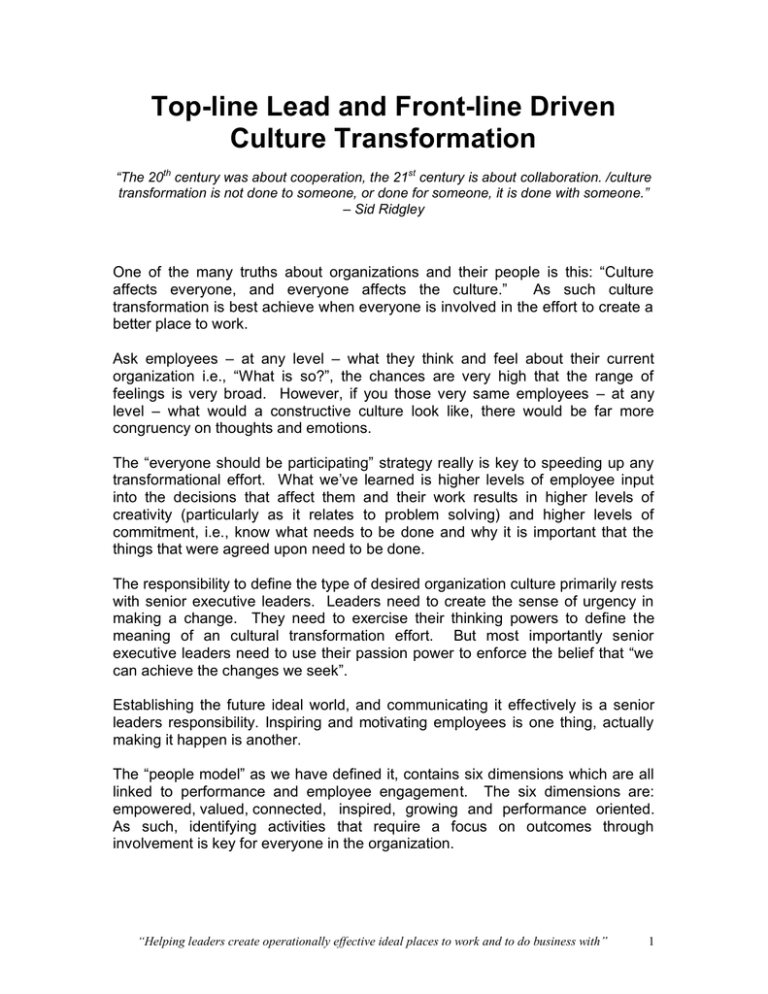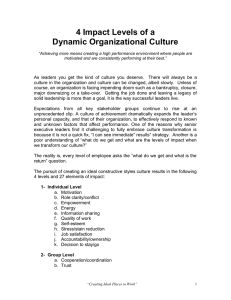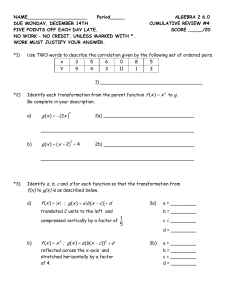
Top-line Lead and Front-line Driven
Culture Transformation
“The 20th century was about cooperation, the 21st century is about collaboration. /culture
transformation is not done to someone, or done for someone, it is done with someone.”
– Sid Ridgley
One of the many truths about organizations and their people is this: “Culture
affects everyone, and everyone affects the culture.”
As such culture
transformation is best achieve when everyone is involved in the effort to create a
better place to work.
Ask employees – at any level – what they think and feel about their current
organization i.e., “What is so?”, the chances are very high that the range of
feelings is very broad. However, if you those very same employees – at any
level – what would a constructive culture look like, there would be far more
congruency on thoughts and emotions.
The “everyone should be participating” strategy really is key to speeding up any
transformational effort. What we’ve learned is higher levels of employee input
into the decisions that affect them and their work results in higher levels of
creativity (particularly as it relates to problem solving) and higher levels of
commitment, i.e., know what needs to be done and why it is important that the
things that were agreed upon need to be done.
The responsibility to define the type of desired organization culture primarily rests
with senior executive leaders. Leaders need to create the sense of urgency in
making a change. They need to exercise their thinking powers to define the
meaning of an cultural transformation effort. But most importantly senior
executive leaders need to use their passion power to enforce the belief that “we
can achieve the changes we seek”.
Establishing the future ideal world, and communicating it effectively is a senior
leaders responsibility. Inspiring and motivating employees is one thing, actually
making it happen is another.
The “people model” as we have defined it, contains six dimensions which are all
linked to performance and employee engagement. The six dimensions are:
empowered, valued, connected, inspired, growing and performance oriented.
As such, identifying activities that require a focus on outcomes through
involvement is key for everyone in the organization.
“Helping leaders create operationally effective ideal places to work and to do business with”
1
What are the processes in the People Model that support culture transformation?
The 12 processes are: How we:
- Attract
- Recruit
- Induct
- Train
- Grow
- Consult
- Involve
- Reward
- performance manage
- promote
- say goodbye to
and
- lead people.
Are there any of the above processes that wouldn’t benefit from front-line
involvement? We think not.
An important first step in any effort to transform an organization’s culture is to
invite everyone to provide input. Input into “what is so” and input into “what could
be”. Senior executive leaders need to respect the input and then enthusiastically
communication the “what could be”. However achieving that new reality, requires
everyone’s involvement otherwise it simply is wishful thinking on the part of many
in the organization.
Your senior executives have a responsibility to define the type of culture that
would be “ideal” for the enterprise AND they have a responsibility enable and
empower everyone in the organization to “come along” and “make a
contribution”.
Sid Ridgley
Tel: +1 905-895-7900
Toll free: +1-888-291-7892
Email: sridgley@simulcorp.com OR sidridgley@utilitypulse.com
About the Author:
Sid Ridgley is an organization culture transformation specialist who has
extensive real-life business experience. For over 30 years he has assisted
leaders in creating more value.
© Copyright, all rights reserved 2012
“Helping leaders create operationally effective ideal places to work and to do business with”
2



